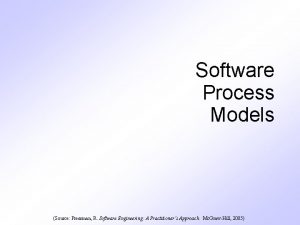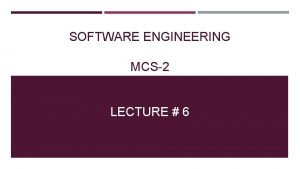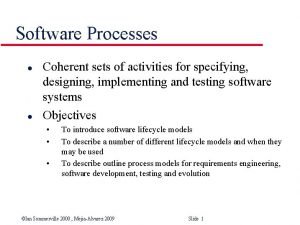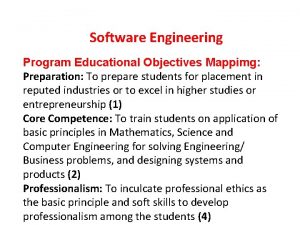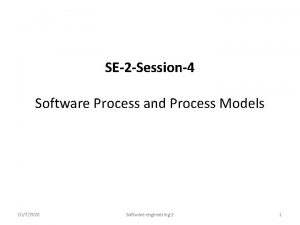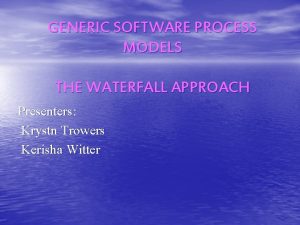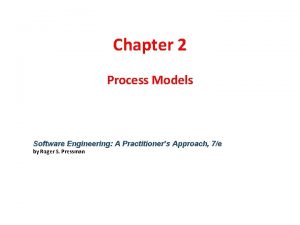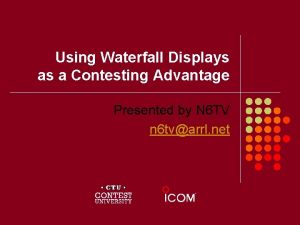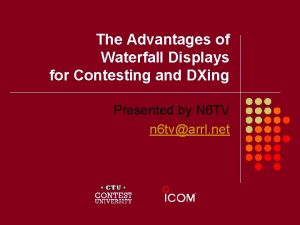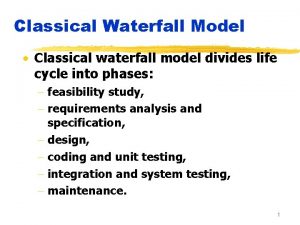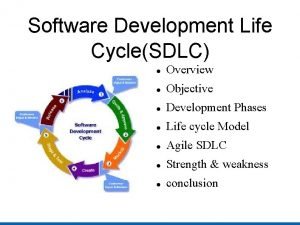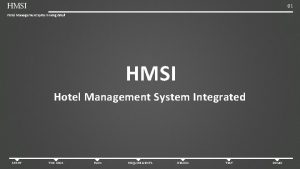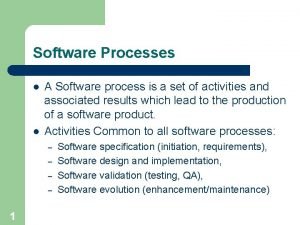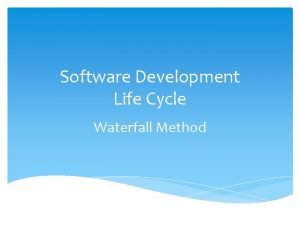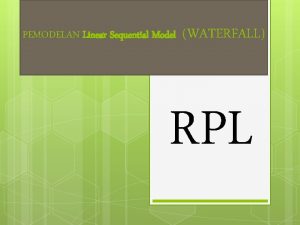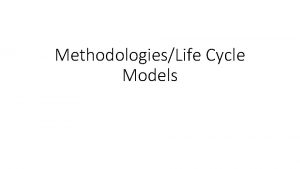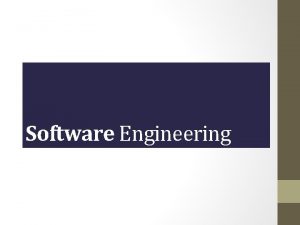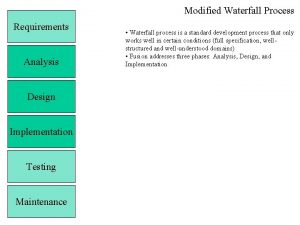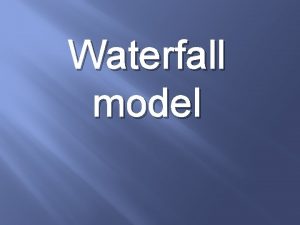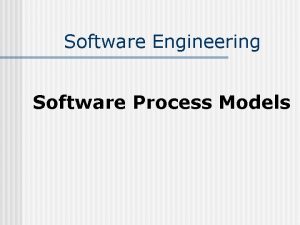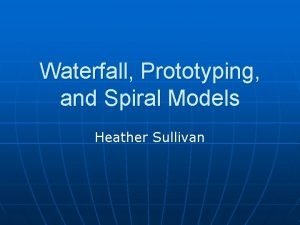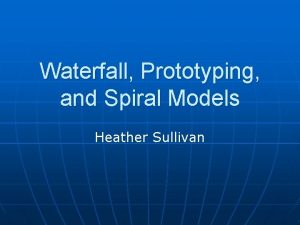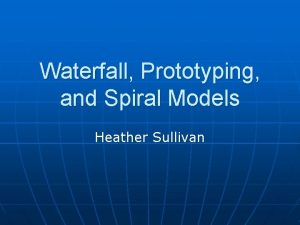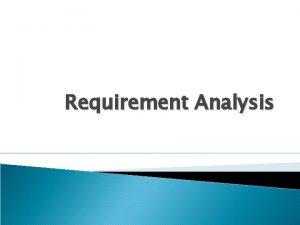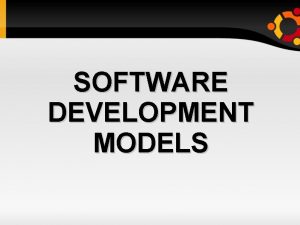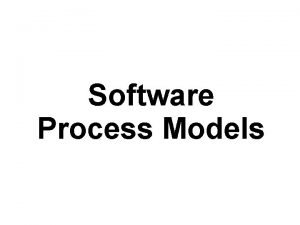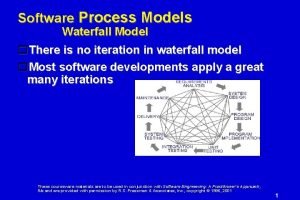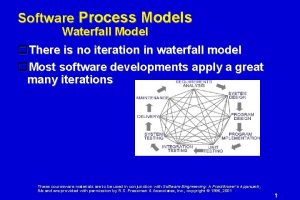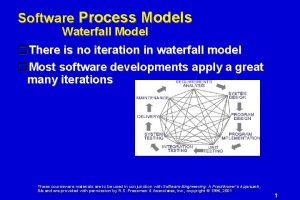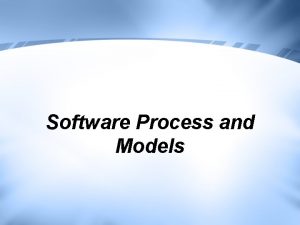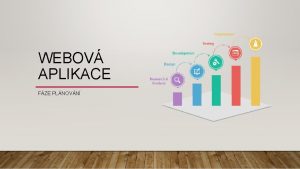Software Process Models Lecture 03 1 Waterfall Model























- Slides: 23

Software Process Models Lecture 03 1

Waterfall Model for Development • Here, steps (phases) are arranged in linear order – A step take inputs from previous step, gives output to next step (if any) – Exit criteria of a step must match with entry criteria of the succeeding step • It follows ‘specify, design, build’ sequence that is intuitively obvious and appears natural 2

Waterfall Model … • Produces many intermediate deliverables, usually documents – Standard formats defined – Act as ‘baseline’ used as reference (for contractual obligations, for maintenance) – Important for quality assurance, project management, etc. • It is widely used (with minor variations) when requirements are well understood 3

Waterfall Model system engineering -software part of some larger system -establish requirements for all elements of the system; assign some to software -understand information domain, functions, performance and interfacing. Project plans made Analysis Project planning -translate requirements into s/w architecture, data structures and procedural details. A ‘detailed design’ step can be added design code -programming testing & integration -test logic and function interfaces Installation & maintenance -deployment; make changes for -Errors, performance -changes in requirement 4

Deliverables in Waterfall Model • Project plan and feasibility report • Requirements document (SRS : Software Requirement Specifications) • System design document • Detailed design document • Test plans and test reports • Source code • Software manuals (user manual, installation manual) • Review reports 5

Cost/Effort Distribution Total accumulated cost Problem Feasibility Analysis definition study System design Detailed design Implemen- Maintentation ance • Accumulated cost increases dramatically as programmers, operators, technical writers and computer time is committed. • Cost of discovering and fixing errors also increases with steps 6

Shortcomings of Waterfall Model • Requirements may not be clearly known, especially for applications not having existing (manual) counterpart – Railway reservation: manual system existes, so SRS can be defined – On-line container management for railways - new – Knowledge management for a central bank – new 7

Shortcomings … • Requirements change with time during project life cycle itself – Users may find solution of little use – Better to develop in parts in smaller increments; this is common for packages, system software • Considered documentation-heavy: so much documentation may not be required for all types of projects. 8

Prototyping Model • When customer or developer is not sure – Of requirements (inputs, outputs) – Of algorithms, efficiency, human-machine interaction • A throwaway prototype built from currently known user needs • Working or even ‘paper’ prototype 9

Prototyping … • Quick design focuses on aspects visible to user; features clearly understood need not be implemented • Prototype is tuned to satisfy customer needs – Many iterations may be required to incorporate changes and new requirements • Final product follows usual define-design-build-test life cycle 10

Prototyping Requirements gathering ‘Quick’ design build prototype evaluate & refine Engineer product 11

Limitations of Prototyping • Customer may want prototype itself ! • Developer may continue with implementation choices made during prototyping – may not give required quality, performance, …. • Good tools need to be acquired for quick development • May increase project cost 12

Iterative Development • Useful for product development where developers define scope, features to serve many customers • Early version with limited feature important to establish market and get customer feedback • Initial version may follow any method • A list of features for future versions maintained • Each version is analyzed to decide feature list for next iteration 13

Spiral Model • Activities are organized in a spiral having many cycles • Four quadrants in each cycle 1. Determine objectives, Alternatives, constraints 4. Plan next step 2. Evaluate alternatives, identify and handle risks 3. Develop the software 14

Spiral Model … • Prototyping, simulations, benchmarking may be done to resolve uncertainties/risks • Development step depends on remaining risks; e. g. , – Do prototype for user interface risks – Use basic waterfall model when user interface and performance issues are understood but only development risk remains • Risk driven : allows us mix of specification-oriented, prototype-oriented, simulation based or any other approach. 15

The Spiral Model 16

Spiral Model • Main characteristics: – Also a hybrid model that support process iteration – The process is represented as a spiral, each loop in the spiral representing a process phase – Four sectors per loop: objective setting, risk assessment and reduction, development and validation, planning – Risk is explicitly taken into consideration 17

Spiral Model • Advantages: – Risk reduction mechanisms are in place – Supports iteration and reflects real-world practices – Systematic approach • Disadvantages: – Requires expertise in risk evaluation and reduction – Complex, relatively difficult to follow strictly – Applicable only to large systems • Applicability: – Internal development of large systems 18

Project Management Process • Runs in parallel to development process • Project planning, monitoring and control are the basic goals • Project plan indicates how project will be executed successfully – – Without plan, there is no management Without measurement, not much planning possible Plan allows progress to be measured Plan produced before development begins and constantly updated 19

Project Planning • Prepare cost/effort estimation – Based on project complexity, scope, productivity levels, other historical data – Many models available • Select development process, define milestones and prepare schedule – Know how effort is distributed over phases from historical data • Decide project staffing • Make quality control plans: define reviews, inspections, testing strategies to detect/remove defects 20

Project Monitoring and Control • Plan defines various activities: many ways to represent: Gantt chart, time bar chart, PERT/CPM project activity network – Show activities, expected durations, resources allocated – Critical paths can be identified 21

Project monitoring … • Each development step gives information for tracking progress for identifying delays, bottlenecks, etc. – Allows corrective action: add more resources reduce scope, re-negotiate cost/schedule, etc. 22

Summary • Challenges in software development and need for ‘engineering’ approach – Step-by-step methodology with specific deliverables • Types of software processes – For development, for project management, … • Precise definition of a step • Waterfall model : natural, widely followed in spite of its limitations • Project management – for planning, monitoring and control 23
 Overview of software engineering
Overview of software engineering 01:640:244 lecture notes - lecture 15: plat, idah, farad
01:640:244 lecture notes - lecture 15: plat, idah, farad What is software process model
What is software process model Evolutionary software process models
Evolutionary software process models Software maintenance in software engineering ppt
Software maintenance in software engineering ppt Evolutionary software process models
Evolutionary software process models Evolutionary software process models
Evolutionary software process models Evolutionary software process models
Evolutionary software process models Generic software process models
Generic software process models Generic process model in software engineering
Generic process model in software engineering Waterfall display software
Waterfall display software Waterfall display software
Waterfall display software Modal and semi modals
Modal and semi modals Classical waterfall model
Classical waterfall model Model iteracyjny
Model iteracyjny Objective of sdlc
Objective of sdlc Process model for hotel management system
Process model for hotel management system Waterfall model for hotel management system
Waterfall model for hotel management system Waterfall 모델
Waterfall 모델 Advantages of waterfall model
Advantages of waterfall model Sdlc for dummies
Sdlc for dummies Linear sequential model adalah
Linear sequential model adalah Modified waterfall model
Modified waterfall model Modified waterfall model advantages and disadvantages
Modified waterfall model advantages and disadvantages


